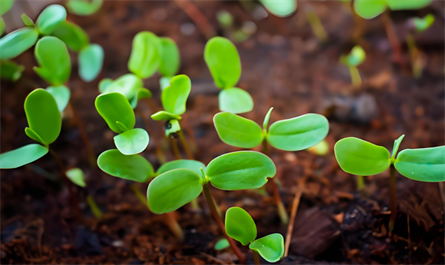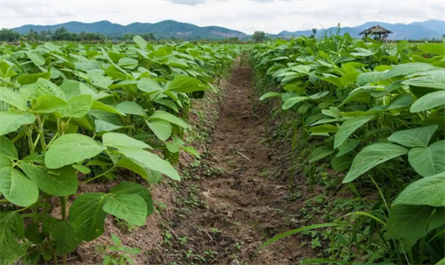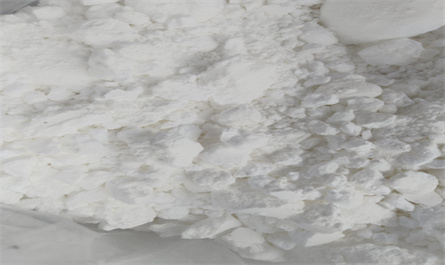The difference in the effects of different plant growth retardants
Plant growth retardants are essential in the process of crop cultivation. By regulating the vegetative growth and reproductive growth of crops, better quality and higher yield can be achieved. Plant growth retardants usually include paclobutrazol, clofosbuvir, mepiquat, chlormequat, etc. As a new type of plant growth retardant, prohexadione calcium has received widespread attention in the market in recent years, and the number of registrations has also increased rapidly. So, what are the differences between paclobutrazol, clofosbuvir, mepiquat, chlormequat, and prohexadione calcium in market applications? The author will introduce them to you one by one!

(1) Prohexadione calcium: It is a new type of plant growth retardant.
Its typical action characteristics are: it can inhibit GA1 in Gibberellic Acid (GA3), shorten the elongation of plant stems, and thus control the elongation of plants. At the same time, it has no effect on GA4 that controls plant flower bud differentiation and grain development.
Prohexadione calcium was launched in Japan in 1994. It is a new plant growth regulator developed by Kuibo Chemical Industries, Ltd. It belongs to the acylcyclohexanedione growth retardant. The discovery of prohexadione calcium is different from plant growth retardants such as quaternary ammonium salts (Chlormequat Chloride, Mepiquat chloride) and triazoles (Paclobutrazol, Uniconazole). It has opened up a new field of late inhibition of gibberellin biosynthesis.
It has been commercialized and widely used in Europe and the United States. At present, prohexadione calcium has attracted widespread attention from domestic companies. The main reason is that compared with triazole retardants, prohexadione calcium has no residual toxicity to rotation plants and no pollution to the environment, which is a strong advantage. In the future, it may replace triazole growth retardants and has broad application prospects in fields, fruit trees, flowers, Chinese medicinal materials and economic crops.

(2) Paclobutrazol:
an inhibitor of endogenous gibberellic acid in plants. It has the effects of slowing plant growth, inhibiting stem elongation, shortening internodes, promoting tillering, increasing plant stress resistance, promoting flower bud differentiation, and increasing yield. Paclobutrazol is suitable for crops such as rice, wheat, peanuts, fruit trees, soybeans, and lawns, and has a significant effect in controlling excessive growth.
Side effects of Paclobutrazol: Excessive use can cause dwarf plants, deformed tubers, curled leaves, dumb flowers, premature shedding of old leaves at the base, twisting and shrinking of young leaves, etc. Since Paclobutrazol has a long duration of efficacy, excessive use will remain in the soil and cause damage to the next crop, resulting in no seedlings, late seedlings, low seedling emergence rate, seedling deformities and other symptoms.
(3) Uniconazole:
It is also an inhibitor of gibberellins. It has the functions of regulating vegetative growth, shortening internodes, dwarfing plants, promoting lateral bud growth and flower bud differentiation, and enhancing stress resistance. Since Uniconazole has a carbon double bond, its biological activity and medicinal effect are 6 to 10 times and 4 to 10 times higher than Paclobutrazol respectively, while its soil residue is only about a quarter of Paclobutrazol, and its medicinal effect decays faster, and its impact on the next crop is only 1/5 of Paclobutrazol.
Side effects of uniconazole: Excessive dosage can cause plant damage, such as burns, withering, poor growth, leaf deformities, leaf drop, flower drop, fruit drop, and late maturity. In addition, its application in the seedling stage of vegetables can affect the growth of seedlings. It is also toxic to fish and is not suitable for use in fish ponds and other aquatic animal farms.

(4) Mepiquat chloride:
It is an inhibitor of gibberellins. It can enhance the synthesis of chlorophyll and strengthen plants. It can be absorbed through the leaves and roots of plants and transmitted to the whole plant, thereby inhibiting cell elongation and apical dominance. It can also shorten internodes and make the plant compact. It can delay the vegetative growth of plants, prevent excessive growth, and delay row closure. Mepiquat chloride can improve the stability of cell membranes and increase plant resistance. Compared with Paclobutrazol and Uniconazole, it is milder and non-irritating, with higher safety. It can be applied at all stages of the crop, even during the seedling and flowering stages when crops are very sensitive to drugs, and has basically no adverse side effects.
(5) Chlormequat Chloride: It achieves the effect of controlling excessive growth by inhibiting the synthesis of endogenous gibberellins. Chlormequat Chloride has a regulatory effect on plant growth, balancing vegetative growth and reproductive growth, improving pollination and fruit setting rate, and increasing effective tillering. Delaying cell elongation results in dwarfed plants, thicker stems, and shorter internodes.
Unlike Paclobutrazol and Mepiquat chloride, Paclobutrazol is typically used during the seedling and new shoot stages, and is effective for peanuts, but generally less effective for autumn and winter crops. Chlormequat Chloride is primarily used during the flowering and fruiting stages, and is often used on crops with a short growth period. However, improper use of Chlormequat Chloride often causes fruit shrinkage, and the damage is difficult to correct. Mepiquat chloride is more mild, and damage can be alleviated by spraying gibberellins or watering to increase fertility.

(1) Prohexadione calcium: It is a new type of plant growth retardant.
Its typical action characteristics are: it can inhibit GA1 in Gibberellic Acid (GA3), shorten the elongation of plant stems, and thus control the elongation of plants. At the same time, it has no effect on GA4 that controls plant flower bud differentiation and grain development.
Prohexadione calcium was launched in Japan in 1994. It is a new plant growth regulator developed by Kuibo Chemical Industries, Ltd. It belongs to the acylcyclohexanedione growth retardant. The discovery of prohexadione calcium is different from plant growth retardants such as quaternary ammonium salts (Chlormequat Chloride, Mepiquat chloride) and triazoles (Paclobutrazol, Uniconazole). It has opened up a new field of late inhibition of gibberellin biosynthesis.
It has been commercialized and widely used in Europe and the United States. At present, prohexadione calcium has attracted widespread attention from domestic companies. The main reason is that compared with triazole retardants, prohexadione calcium has no residual toxicity to rotation plants and no pollution to the environment, which is a strong advantage. In the future, it may replace triazole growth retardants and has broad application prospects in fields, fruit trees, flowers, Chinese medicinal materials and economic crops.

(2) Paclobutrazol:
an inhibitor of endogenous gibberellic acid in plants. It has the effects of slowing plant growth, inhibiting stem elongation, shortening internodes, promoting tillering, increasing plant stress resistance, promoting flower bud differentiation, and increasing yield. Paclobutrazol is suitable for crops such as rice, wheat, peanuts, fruit trees, soybeans, and lawns, and has a significant effect in controlling excessive growth.
Side effects of Paclobutrazol: Excessive use can cause dwarf plants, deformed tubers, curled leaves, dumb flowers, premature shedding of old leaves at the base, twisting and shrinking of young leaves, etc. Since Paclobutrazol has a long duration of efficacy, excessive use will remain in the soil and cause damage to the next crop, resulting in no seedlings, late seedlings, low seedling emergence rate, seedling deformities and other symptoms.
(3) Uniconazole:
It is also an inhibitor of gibberellins. It has the functions of regulating vegetative growth, shortening internodes, dwarfing plants, promoting lateral bud growth and flower bud differentiation, and enhancing stress resistance. Since Uniconazole has a carbon double bond, its biological activity and medicinal effect are 6 to 10 times and 4 to 10 times higher than Paclobutrazol respectively, while its soil residue is only about a quarter of Paclobutrazol, and its medicinal effect decays faster, and its impact on the next crop is only 1/5 of Paclobutrazol.
Side effects of uniconazole: Excessive dosage can cause plant damage, such as burns, withering, poor growth, leaf deformities, leaf drop, flower drop, fruit drop, and late maturity. In addition, its application in the seedling stage of vegetables can affect the growth of seedlings. It is also toxic to fish and is not suitable for use in fish ponds and other aquatic animal farms.

(4) Mepiquat chloride:
It is an inhibitor of gibberellins. It can enhance the synthesis of chlorophyll and strengthen plants. It can be absorbed through the leaves and roots of plants and transmitted to the whole plant, thereby inhibiting cell elongation and apical dominance. It can also shorten internodes and make the plant compact. It can delay the vegetative growth of plants, prevent excessive growth, and delay row closure. Mepiquat chloride can improve the stability of cell membranes and increase plant resistance. Compared with Paclobutrazol and Uniconazole, it is milder and non-irritating, with higher safety. It can be applied at all stages of the crop, even during the seedling and flowering stages when crops are very sensitive to drugs, and has basically no adverse side effects.
(5) Chlormequat Chloride: It achieves the effect of controlling excessive growth by inhibiting the synthesis of endogenous gibberellins. Chlormequat Chloride has a regulatory effect on plant growth, balancing vegetative growth and reproductive growth, improving pollination and fruit setting rate, and increasing effective tillering. Delaying cell elongation results in dwarfed plants, thicker stems, and shorter internodes.
Unlike Paclobutrazol and Mepiquat chloride, Paclobutrazol is typically used during the seedling and new shoot stages, and is effective for peanuts, but generally less effective for autumn and winter crops. Chlormequat Chloride is primarily used during the flowering and fruiting stages, and is often used on crops with a short growth period. However, improper use of Chlormequat Chloride often causes fruit shrinkage, and the damage is difficult to correct. Mepiquat chloride is more mild, and damage can be alleviated by spraying gibberellins or watering to increase fertility.
RECENT POSTS
-
Rational Use of Plant Growth Regulators to Promote Fruit Tree Yield and Quality Improvement
-
Combination of Different Plant Growth Regulators with Rooting Hormone
-
Differences and Applications of Zeatin Trans-Zeatin and Trans-Zeatin Riboside
-
14-Hydroxylated brassinolide Supporting Scientific Planting and Application Analysis of Typical Crops
Featured News



